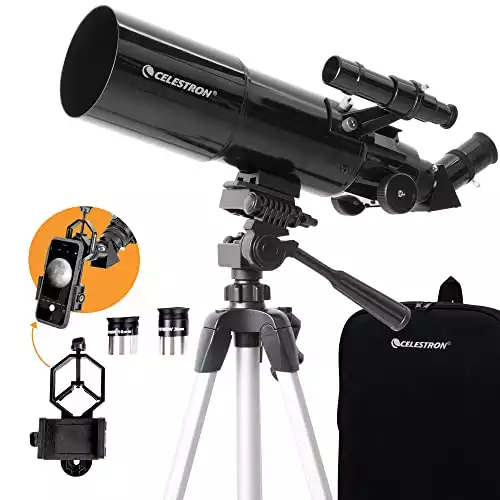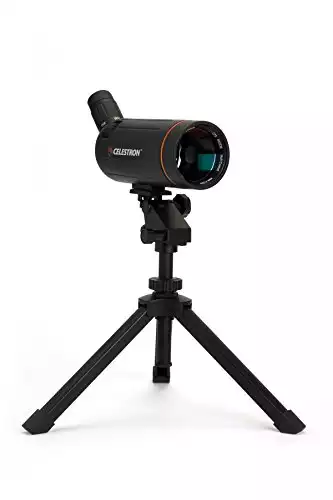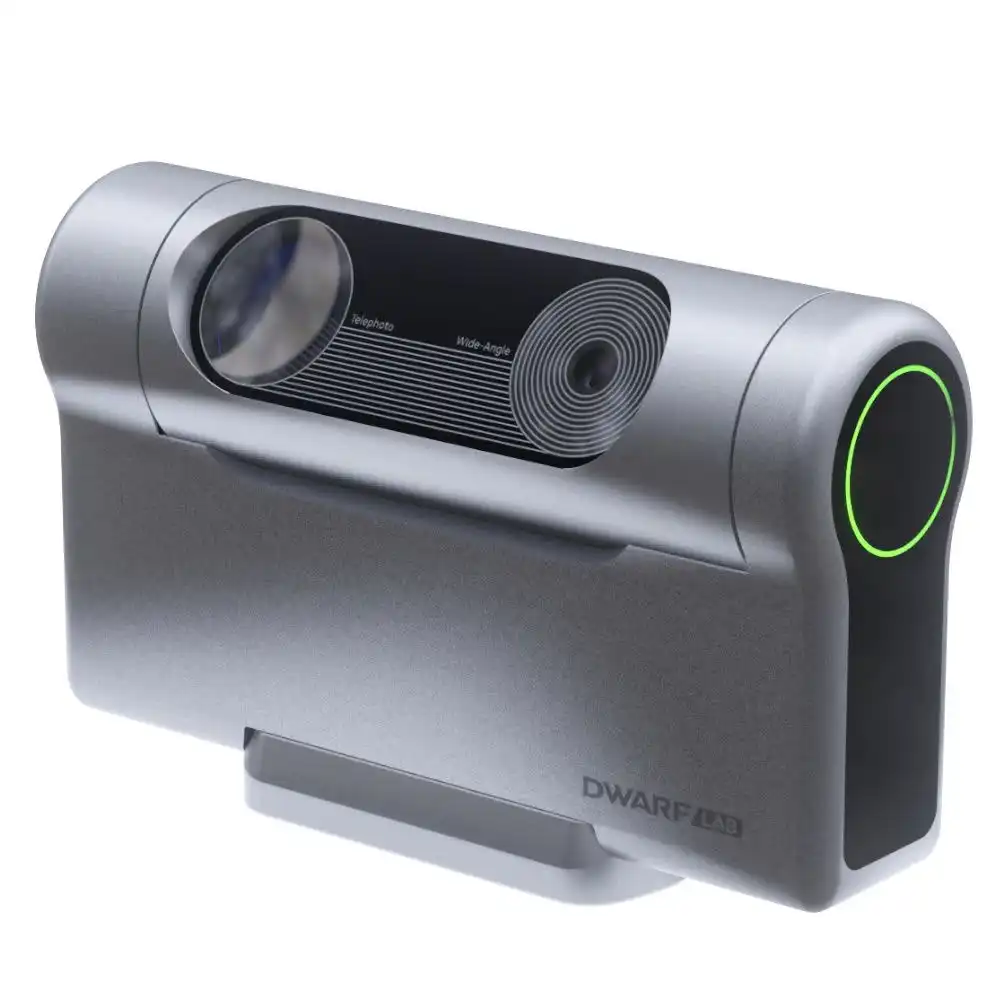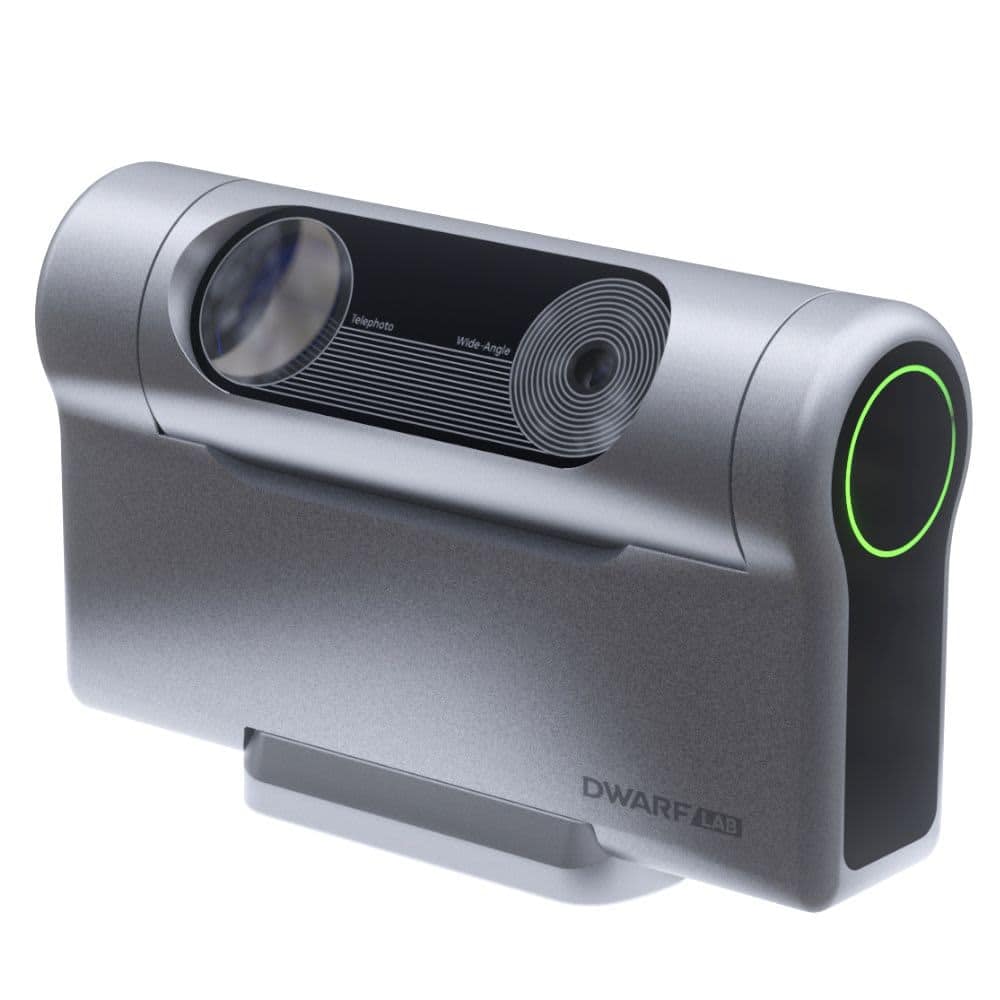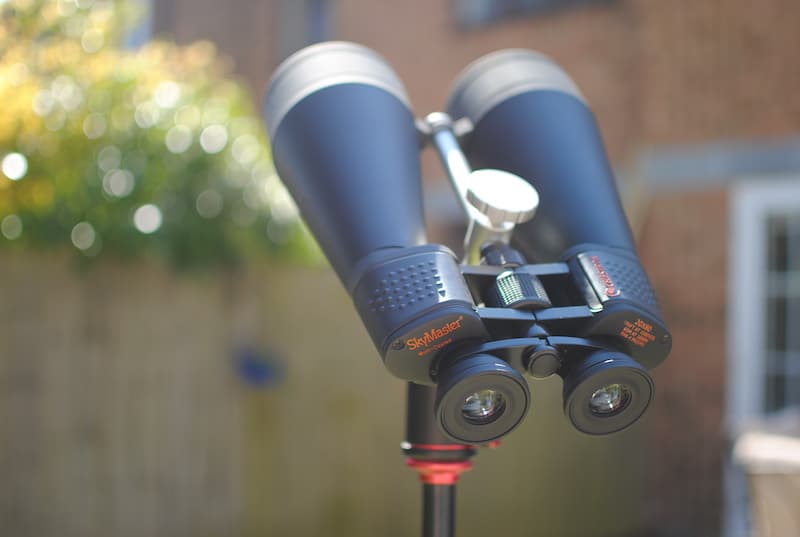If you are looking for a portable telescope to take on a trip then there are some great options to suit different budgets and size capacities
See below for quick links or read on for more detail on each model.
|
Make & Model:
Celestron Travel Scope 80
|
Make & Model:
Celestron C70 Mini Mak
|
Make & Model:
Dwarflab Dwarf 3
|
|
Aperture:
80mm (3")
|
Aperture:
70mm (2.8")
|
Aperture:
35mm (1.6")
|
|
Weight:
4.5 lb (2 kg)
|
Weight:
2.3 lb (1 kg)
|
Weight:
2.8 lb (1.3 kg)
|
Celestron Travel Scope 80
Best Travel Telescope
As the name suggests, the Celestron Travel Scope 80 is specifically designed to be portable for travel and backpacking.
Weighing just 4.5 lbs it is light and perfect for taking on trips. No tools are required to quickly and easily get it set up. It comes with a backpack included with space for all the accessories, including the tripod.
As part of the package, it also comes with a smartphone adapter so that you can use it to take photos, and a Bluetooth remote so that you can shoot without having to touch your phone and shake the telescope.
The tripod can stand up to 52 inches (132 cm) tall and there is what is known as an Alt-Azimuth mount – this means that it is easy to operate with a handle and so you just point and look at what you want to see.
The 80mm aperture (the best measure of a telescope’s power) is enough to give you bright views of objects in the night sky.
Here is a quick video overview of this series of telescopes:
Celestron has really tried to think of everything with this so that you can just buy in one and have confidence that you can throw it in the car and have all you need to get going quickly when traveling.
We regard it as the best travel telescope as it is the most powerful of the Celestron Travel Scope range, gives you all you need in one, and is great value for the price it retails at.
Pros:
- All in one package including backpack and tripod
- Easily set up with no tools and easily packed up into the supplied backpack
- Enough power for great viewing
- Capacity to take photos with your smartphone and adapter included
- Relatively inexpensive
Cons:
- Although 80mm aperture is good, this is still a relatively small telescope and so don’t expect too much in terms of what you might see through it
Key specifications
- Type: Refractor
- Aperture: 80 mm (3.1 inches)
- Focal Length: 400 mm (16 inches)
- Focal Ratio: F/5
- Weight: 4.5 lb (2 kg)
- Accessories: Backpack, Tripod, Smartphone Adapter & Bluetooth Remote, Finderscope, Erect Image Diagonal, 2 Eyepieces, 3x Barlow Lens, Moon Filter
Portable travel telescope package
- All in one package including backpack, tripod and smartphone photography adapter
- Easily set up with no tools and neatly packs up into the supplied backpack
- 80mm aperture for great views
Other Celestron Travel Scopes (including DX Range)
There are a number of different models within the Celestron Travel Scope range. These are all identical apart from having a different aperture.
Aperture is the measurement of how wide the lens of the telescope is – the higher the number, the better the views you will have.
The telescope outlined above has an 80mm aperture and this is the most powerful in the range. The others are available with smaller 50mm, 60mm, or 70mm apertures.
You can check prices at a number of different retailers with the links here:
- Celestron Travel Scope 50
- Celestron Travel Scope 60
- Celestron Travel Scope 60 DX
- Celestron Travel Scope 70
- Celestron Travel Scope 70 DX
Celestron Travel Scope DX range
The Travel Scope DX range are exactly the same but just with a new color scheme.
It therefore makes little difference if you buy a DX version or not. Just check the price and what’s included in the accessories as this may vary.
Celestron C70 Mini Mak
It is sold as a spotting scope but is actually a very small telescope.
This light and portable package comes with a mini tabletop tripod included.
It has a built-in zoom eyepiece so that you can adjust it from 25x up to 75x. This is interchangeable with other eyepieces using the included adapter.
Overall, this is a great option if you want something ultra-portable to take out on hikes or trips. It is definitely the smallest and lightest on this list yet is of high quality design.
If you like the idea of this but want more power, then you can also consider the larger Celestron C90 Mak.
- Ultra-light at just 1kg
- Small and compact for easy travel
- Built-in zoom eyepiece allowing up to 75x magnification (and can be used with other eyepieces)
- Mini-tripod and carry bag included
- Cheap and good budget option
- Lower aperture than the model above and so the views will not be as good
- No smartphone adapter included
- You’ll need to be somewhere with a table or similar height object to rest it on to use with the included tripod (although it can also be used with a regular photography tripod if you have one).
- Type: Maksutov-Cassegrain
- Aperture: 70 mm (2.8 inches)
- Focal Length: 750 mm (30 inches)
- Focal Ratio: F/11
- Weight: 2.3 lb (1 kg)
- Accessories: Table-top tripod, interchangeable eyepiece adapter, soft-side carry case.
Compact spotting scope with 25-75x zoom magnification and 70mm aperture lenses
- Maksutov-Cassegrain optical design with 70mm aperture multi-coated optics
- Built-in 25-75x magnification zoom eyepiece
- Includes tabletop tripod and soft carrying case
- Brings portability and versatility to a new level
- Applicable for both terrestrial (land) and astronomical use
- Lower aperture than the Celestron C5 and C90 spotting scopes
- Too small to be able to support a DSLR/mirrorless camera but can be used with a smartphone
- Needs a tabletop to use with the included tripod (although it can also be used with a regular full-height tripod)
Dwarflab Dwarf 3
Most Portable Smart Telescope
Something different from the above telescopes, the Dwarf 3 is a smart telescope.
This means that it is a device that includes a telescope and camera in one unit and is controlled by an app on your photo to take images of objects in the night sky (and the sun in the daytime with included filter).
The Dwarf 3 is brand new and is the most portable smart telescope. Not only is it small and light but it also comes with a perfect carry case.
This is perfect if you want something portable to take on a trip and take astrophotography images with, maybe to take advantage of dark skies if you are away from urban areas.
Just know that you cannot look through it like a regular telescope – only view the images on your smartphone.
There are a number of great smart telescopes if you’d like to compare this model with others – see our comparison article here or watch the video below:
Pros:
- Small, light and comes in a perfectly fitted and cushioned carry case for travel
- Takes astrophotography images at the press of a button from your smartphone
Cons:
- Cannot be used for visual astronomy
Key specifications
- Type: Smart Telescope
- Aperture: 35 mm (1.4 inches)
- Focal Length: 150 mm (5.9 inches)
- Weight: 2.8 lbs (1.3 kg)
- Accessories: Tripod, Carry Bag
Budget Smart Telescope
- Shoot deep space objects in minutes with no expertise or experience necessary
- Great value at a budget price
- Light and portable - easy to store and travel with
- Limited image quality with relatively low aperture
- Not good for planetary imaging with short focal length
- Slightly fiddly setup and calibration processes
Travel Telescopes vs Binoculars, Monoculars & Spotting Scopes
When looking at portable telescopes it’s worth considering whether they are actually the best thing for you or whether or not you could consider looking at binoculars, monoculars, or spotting scopes.
All of these boast the features you are looking for in a travel telescope:
- Portability
- Ease-of-use
- Good astronomy viewing capabilities
In addition, it can be quite hard to find the telescope model you want in stock due to recent supply chain disruption and increased demand for telescopes with more people looking for hobbies to do at home. So opening up your options might make sense.
Below we outline why you might want to consider one of these alternatives and recommend the best options.
Astronomy Binoculars vs Travel Telescopes
Astronomy binoculars are a great alternative to travel telescopes. They are:
- Compact, portable and durable, and so easy to travel with
- Can be used handheld without a tripod and other accessories
- Quick and easy to use
- Similar price range to budget portable telescopes
You can get very big astronomy binoculars that need tripods and if you intend to do photography you will need a tripod anyway (plus a smartphone adapter), so please note that.
See our article on the Best Astronomy Binoculars.
Monoculars vs Travel Telescopes
Monoculars are the best budget option if you want something cheap and easy to fit in your bag or pocket.
They are very small, weatherproof and durable and so make for great alternatives to travel telescopes or binoculars.
For recommendations on the best models, see the Best Monoculars for Stargazing.
Spotting Scopes vs Travel Telescopes
Lastly, for a different option you could consider a spotting scope. These have higher quality optics than monoculars.
They are more designed for bird watching or other daytime activities, but they will definitely give you great views of the moon and other objects in the night sky.
The reason why they might work in place of a travel telescope is that they are lightweight and portable and comes with a carry bag, tabletop tripod, and smartphone adapter for photography.
They are bigger than monoculars and binoculars and you can even buy a separate adapter to attach a DSLR camera directly to the spotting scope (as you also can with a telescope).
They can have a similar aperture to the travel telescopes above and many models allow you to use astronomy eyepieces.
They are made to be durable and weatherproof as well though, which can be a big positive over the telescopes that need to be handled with a little more care.
Downsides to consider are:
- Not specifically for astronomy and might limit your viewing beyond the moon (apart from the Celestron model above)
- Tabletop tripods mean you need to put it on something or be sitting/lying down, which may not be convenient for night sky viewing
For a detailed overview, see the Best Spotting Scopes for Astronomy.
What to Look for in a Portable Telescope
Factors worth considering when buying a travel telescope are:
- Size: How bulky is it?
- Weight: How much does it weigh?
- Portability: Does it easily pack up in a bag, case or backpack?
- Durability: Will it be ok being transported and potentially taking some small knocks?
- Weather resistance: Will it be ok if it the cold, hot, dry, or wet?
- Usability: How easy is it to set up and use when you are out traveling?
All three of the telescopes listed above should meet all these criteria, although the other options of binoculars/monoculars/spotting scopes may win on durability and weather resistance.
Travel Telescope Specifications
All telescopes are also characterized by certain specifications and types. This can be fairly confusing and you are often faced with more information than you know what to do with when you just want a good portable telescope.
Here’s a quick rundown of the key specifications and what they mean:
- Aperture: The measure of the width of the lens and the best measure of a telescope’s viewing capabilities. The higher the better as this means brighter views.
- Focal length: This indicates how zoomed in your view will be. Higher focal lengths are good for viewing the moon and planets of our solar system.
- Telescope type: There are three main telescope types: reflectors, refractors, and compound/catadioptrics. For travel telescopes, refractors are best as they require no calibration and are usually fairly durable, as well as being small and light. Reflectors are far too heavy and bulky and require collimation. A GOTO catadioptric could work but is not as durable and also requires collimation.
- Mount type: There are two telescope mount types: Alt-Azimuth and Equatorial. For portable telescopes, Alt-Azimuth is best as they are much lighter and simpler to set up and use. Equatorial mounts are better for astrophotography but are heavy, bulky, and harder to set up and operate.
- Computerized/GOTO: A GOTO mount can scan the sky, tell you what is above you and find it at your control from a hand controller or smartphone app. These are great but more expensive and require a power source when traveling.
Travel Telescope Accessories
You will also see a number of different accessories listed with each telescope. Here’s a quick run-through of what each is, but don’t worry too much as these telescope packages are designed to come with exactly what you need to get the most from them:
- Finderscopes: A piece of equipment that attaches to the side of the telescope that you can look through to help point the tube where you want it to look.
- Eyepieces: Different eyepieces can be used to give you a different field of view, i.e. wider for more sky, or higher magnification to zoom in on specific objects.
- Barlow Lenses: These can sit behind the eyepiece and multiply the magnification of your view.
- Tripods: What the telescope sits upon and is fairly important. It’s worth checking the height of the tripods included if you are tall. The tripods with the telescope packages recommended here are “good enough” without being super sturdy. You can swap these out for other tripods though if you have one.
- Smartphone/DSLR camera adapters: These enable you to attach your phone or camera to the telescope so that you can take pictures through it. This is known as digiscoping or afocal photography, where the camera is hovering above the eyepiece.
- Erect Image Diagonal: These sit on the eyepiece and allow you to look through at a more convenient angle.
FAQs: Best Travel Telescopes
What is the best travel telescope for beginners?
The Celestron Travel Scope 80 and Celestron C70 Mini Mak are perfect travel telescopes for beginners since they are good quality, easy to use, and include all you need in one package.
What is the best travel telescope for astrophotography?
The Dwarflab Dwarf 3 is the perfect travel telescope for astrophotography.
What is the best handheld telescope?
A high-powered monocular like the Celestron 10x50mm Outland is a great handheld telescope.
See more options in our article on the Best Monoculars for Stargazing.
How do you travel with a telescope? Can I bring a telescope on a plane?
It depends on how you are traveling but you should have a bag or case that can protect the telescope when put in a car with other luggage.
If traveling on a plane you should be able to take one of these telescopes in carry-on luggage if you can fit it. This also means you can take better care of it yourself.
You could also put it in your checked luggage but then it is essential that it is safely stored in a case that will protect it from being thrown around with other bags.
The Best Portable Telescopes
Overall, we recommend:
- The Celestron Travel Scope 80 is the best all round travel telescope. It is suitable for beginners, has a good viewing capacity, and is great value for the price.
- The Celestron C70 Mini Mak is the smallest and is an ultra-compact telescope that is great for hiking and camping. You can also consider the C90 version if you want something a little bigger.
- The Dwarf 3 is a brilliant portable smart telescope. This is perfect if you want to take astophotography images when travelling.
We hope you found what you are looking for. Let us know in the comments below if you have any questions.


